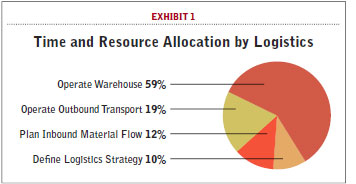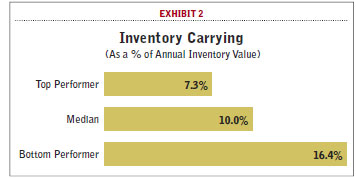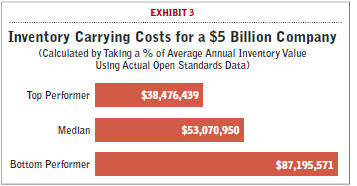Inventory Optimization: Show Me the Money
Minimizing inventory investment and carrying costs while maintaining high service levels can be a tough balancing act. But best-practice companies have shown that it can be done - profitably.
Latest Logistics News
LM Podcast Series: Assessing the freight transportation and logistics markets with Tom Nightingale, AFS Logistics Investor expectations continue to influence supply chain decision-making Under-21 driver pilot program a bust with fleets as FMCSA seeks changes Diesel back over $4 a gallon; Mideast tensions, other worries cited Four U.S. railroads file challenges against FRA’s two-person crew mandate, says report More NewsMarisa Brown, Director, Knowledge Center, APQC
Companies today face an ongoing balancing act as they try to:
- carry enough inventory to respond quickly to customer demand and minimize transportation costs; and
- minimize investment in inventory, facilities, and equipment to reduce warehousing and storage costs.
How big is this inventory optimization challenge?
Organizations participating in APQC’s Open Standards Benchmarking in logistics report that 59 percent of their logistics labor is allocated to operating warehouses (Exhibit 1). Keeping the optimal amount of inventory on hand could make a difference in this time- and resource-intensive process.

In addition to the time and resource requirements, inventory carrying costs can be significant for organizations juggling the asset vs. service tradeoff. Exhibit 2 shows APQC data for inventory carrying costs.
| WEBCAST: 10 Proven Ways to Cut Your Inventory Costs |
| Wednesday August 31, 2011 at 2:00 PM EDT For supply chain professionals looking for practical tips to lower their inventory costs, this is a “must-attend” event. Ralph Cox from Tompkins Associates will discuss proven procedures, policies, strategies and technology enablers for cutting inventory costs - and improving the bottom line. Click Here for more Information |
At the midpoint (median), organizations spend 10 percent of the annual value of their inventory to carry it. Bottom performers spend more than twice what top performers spend to carry their inventory (16.4 percent compared to 7.3 percent of annual inventory value).

The cost to carry inventory translates to a dollar impact on the organization. Exhibit 3 demonstrates the effect on the bottom line for a sample company with $5 billion in revenue. According to APQC’s Open Standards data, the median inventory value as a percentage of revenue is 10.6 percent, so for a company with $5 billion in revenue that would amount to $530,709,500. Using the median inventory value, the gap in inventory carrying cost between top and bottom performers would be more than $48 million.

How can your organization optimize inventory to avoid excessive carrying costs and still satisfy demand? APQC’s best practices report Inventory Optimization: Balancing the Asset vs. Service Tradeoff reveals that the solution lies in creating an inventory optimization program focused on good design, effective processes, appropriate technology, and regular assessment. The discussion below addresses these key elements.
Key Components of Inventory Optimization
How do you determine the needs and objectives of each process area integrated across functions and of your suppliers and customers? Our best practices report points to sharing collaborative demand and supply information among supply chain partners, and using the information to optimize your global network to find the best balance between inventory levels and customer service. A well-designed strategy should incorporate senior management support, periodic evaluations, managing service levels, and partnering with suppliers.
Senior management support. Senior leadership should define, support, and enforce any new inventory optimization effort because it is interdisciplinary and will touch every aspect of the organization—from logistics and procurement to HR, sales, and marketing. The involvement of senior management ensures full organizational alignment. Make sure that your senior management team reinforces inventory optimization as a strategic initiative by committing budget and resources to the effort.
Periodic evaluation. A periodic evaluation of the supply chain design addresses inefficiencies in the physical network and ensures sufficient capacity to support business requirements. In supply chain design, the aim is to remove waste caused by or contained in the supply chain network itself. Identifying these inefficiencies can lead to opportunities for consolidation or realignment. Additionally, reevaluating the design at regular intervals helps position the physical network to support the changing marketplace. Drivers include demand growth and shifts, increased customer service requirements, and globalization of suppliers. These tend to require an organization to shift or expand its supply chain footprint.
Managing service levels. Because improvement of customer service is a primary objective of inventory optimization, it is imperative to maintain and improve service levels during the transformation process to ensure stakeholder buy-in and momentum for the initiative. Once leadership has defined the organization’s service policy, determine the sufficient target inventory levels based not only on the service policy, but also on the effectiveness of the supporting processes and technology.
| WEBCAST: 10 Proven Ways to Cut Your Inventory Costs |
| Wednesday August 31, 2011 at 2:00 PM EDT For supply chain professionals looking for practical tips to lower their inventory costs, this is a “must-attend” event. Ralph Cox from Tompkins Associates will discuss proven procedures, policies, strategies and technology enablers for cutting inventory costs - and improving the bottom line. Click Here for more Information |
Partnering with suppliers. Inventory optimization requires the organization to partner with internal and external suppliers to improve replenishment speed and efficiency. This applies to all goods, whether internally produced or purchased from the outside. Two components are essential here: communication and accountability. Effective communication involves teamwork, collaboration, and visibility. Accountability encompasses making decisions with respect to the organization as a whole, not simply optimizing one function or sub-process. Accountability is critical when opposing forces meet within the same supply chain: consider the situation where manufacturing receives incentives for high utilization and productivity without regard to the space needed or cost to store those items. Use a planning process that determines the best course of action for the business as a whole. Make the appropriate combination of supplier upstream programs, supplier performance management programs, and supplier relationship management a foundation of your inventory optimization initiative.
Implementing Inventory Processes and Procedures
How do you determine appropriate procedural steps and relationships to manage efficient and integrated inventory practices? Start by realigning roles, responsibilities, and accountabilities, both internally and within supplier organizations. Defining and mapping processes and integrating supplier processes are two keys to achieving better alignment.
Assigning process ownership focuses accountability and helps drive execution of the strategy. Process mapping allows you to target areas for improvement and establish standardized, cross-functional processes with common goals among stakeholders. Establish sales and operations planning and forecasting schedules and maintain purchasing levels and policies to maximize improvement opportunities. By doing so, you set the stage for obtaining the best inventory optimization results.
To achieve lower inventory levels while maintaining or improving customer service, you also need to look beyond your corporate walls. Reach out and set up programs with your supply chain partners to help suppliers streamline their processes and integrate them into your organization’s processes and goals.
Technology as an Enabler of Optimization
How do you use technology to enable your inventory optimization processes? Our best practices study suggests that you start by determining the features and functionality needed to minimize inventory investment and improve customer service. Then, assess how you can implement the technology effectively. By using tools and training wisely, you lay a foundation to get the most out of your inventory technology investment.
Organizations should add incremental technology to stable planning processes where measurement and testing have pointed to functional gaps. You cannot expect technology outside the context of a well-defined and executed process to drive performance on its own. The process—not the technology—is the key as it provides the basis to evaluate needs and define and prioritize objectives. Once you know what you want to achieve, you can determine which technology best supports those objectives. Ideally, the organization should select new technology to support the redesigned processes, rather than redesigning processes around new technology.
| WEBCAST: 10 Proven Ways to Cut Your Inventory Costs |
| Wednesday August 31, 2011 at 2:00 PM EDT For supply chain professionals looking for practical tips to lower their inventory costs, this is a “must-attend” event. Ralph Cox from Tompkins Associates will discuss proven procedures, policies, strategies and technology enablers for cutting inventory costs - and improving the bottom line. Click Here for more Information |
Automating inventory optimization and embedding technology into the planning process enables organizations to maintain an optimal inventory mix. Although inventory optimization has a strategic component, the dynamic nature of the marketplace requires tying effective inventory optimization technology to an organization’s operational processes and systems. Events that will quickly render obsolete a strategic view of inventory optimization include new product introductions, changing demand patterns, and evolving sourcing alternatives. Ensure that these technological exercises are not done only once, but instead are continual and evolve over time.
Finally, to maximize the effectiveness of inventory optimization technology, successful organizations implement training and education programs, set expectations, and provide context to those using the results. The aim of training here is to maximize the effective use of technology and avoid or delay additional IT investments, if possible. You can also use training to provide the foundation necessary to identify functional gaps and seek incremental performance enhancement. By informing the stakeholders, you pave the path for buy-in and confidence in the technology.
Measurement and Continuous Improvement
How do you measure the success of your inventory optimization strategy and continuously improve? Establish key performance indicators to enforce the processes, measure and benchmark progress, and raise expectations to improve capabilities and performance. Use adaptable metrics, and remember the importance of people throughout the program.
Successful organizations monitor inventory optimization via adaptable metrics on supplier performance, customer service, and internal assets. As your organization reaches desired goals or when performance falls short of its potential, you can develop programs with associated metrics to improve performance. The key is to adopt a flexible strategy and metrics that can be adjusted as the environment changes.
Over and above the appropriate metrics, the success of inventory optimization is primarily determined by the quality of the people involved in the process. Make every attempt to acquire, retain, and enhance talent, while driving performance and process improvement down to individual incentives. Engage people and set individual and team goals to achieve optimal performance levels.
The challenge of determining the optimum quantity and positioning of inventory to meet demand is a daunting one. To successfully meet this challenge, organizations must obtain credible demand information and use it to make intelligent, data-driven decisions about their supply chains. Best practices in inventory optimization can help improve service, reduce inventory levels, and meet organization-wide goals. Doing so will drive improvement throughout the entire supply chain and in all process areas in the business.
About Marisa Brown: Marisa Brown leads APQC’s Knowledge Center, a newly established group charged with creating and publishing relevant, meaningful content to APQC members and other clients. In this role, she oversees APQC’s content publishing and synchronizes it with all research deliverables created through APQC’s Research and Advisory Services. In addition, she oversees APQC research agendas for upcoming Collaborative Best Practice studies.
About APQC: A member-based nonprofit founded in 1977, APQC is the leading resource for performance analytics, best practices, process improvement, and knowledge management. For more information, visit apqc.org or call 713-681-4020.
| WEBCAST: 10 Proven Ways to Cut Your Inventory Costs |
| Wednesday August 31, 2011 at 2:00 PM EDT For supply chain professionals looking for practical tips to lower their inventory costs, this is a “must-attend” event. Ralph Cox from Tompkins Associates will discuss proven procedures, policies, strategies and technology enablers for cutting inventory costs - and improving the bottom line. Click Here for more Information |
More “Must Read” related articles on “Inventory Management”
25 Ways to Lower Inventory Costs
How Inventory Optimization Opens Pathways to Profitability

Article Topics
Latest in Logistics
LM Podcast Series: Assessing the freight transportation and logistics markets with Tom Nightingale, AFS Logistics Investor expectations continue to influence supply chain decision-making The Next Big Steps in Supply Chain Digitalization Under-21 driver pilot program a bust with fleets as FMCSA seeks changes Diesel back over $4 a gallon; Mideast tensions, other worries cited Four U.S. railroads file challenges against FRA’s two-person crew mandate, says report XPO opens up three new services acquired through auction of Yellow’s properties and assets More LogisticsSubscribe to Logistics Management Magazine

Find out what the world's most innovative companies are doing to improve productivity in their plants and distribution centers.
Start your FREE subscription today.
April 2023 Logistics Management

Latest Resources














